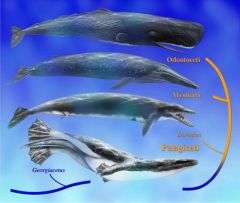All in the Hips: Fossilized Discovery Leads Paleontologist to Find Early Whales Used Back Legs for Swimming

(PhysOrg.com) -- The crashing of the enormous fluked tail on the surface of the ocean is a “calling card” of modern whales. Living whales have no back legs, and their front legs take the form of flippers that allow them to steer. Their special tails provide the powerful thrust necessary to move their huge bulk.
Yet, this has not always been the case. Reporting in the latest issue of the Journal of Vertebrate Paleontology, Dr. Mark D. Uhen, a paleontologist of the Alabama Museum of Natural History at The University of Alabama, describes new fossils from sites near Coffeeville in southwestern Alabama and Newton in southeastern Mississippi that pinpoint where tail flukes developed in the evolution of whales.
“We know that the earliest whales were four-footed, semi-aquatic animals, and we knew that some later early whales had tail flukes, but we didn’t know exactly when the flukes first arose,” Uhen says. “Now we do.”
The most complete fossil described in the study is a species called Georgiacetus vogtlensis. Although not new to science, the new fossils provide new information. In particular, previously unknown bones from the tail show that it lacked tail flukes. On the other hand, it did have large back feet, and Uhen suggests that it used them like modern whales use their tail flukes. Undulating, or moving the body in a wave-like fashion, was a key factor in the evolution of swimming.
“When whales move their flukes through the water, it creates a force to move them forward,” Uhen says. “Georgiacetus is doing something similar with its feet.”
The different body forms seen in the lineage of whales point to different methods of swimming underwater. Previous studies have proposed a possible process to evolve from the ancestral form, paddling with all four legs, to the modern-day whale in which the tail oscillates up and down.
Living vertebrates that are capable swimmers employ a whole range of different techniques, including five particularly well-defined methods: quadrupedal paddling, paddling only using the back legs, undulation of the hips, tail undulation, and tail oscillation.
Interestingly, it had been suggested that during whale evolution that each of these steps occurred in turn, but that the hip undulation stage might have been by-passed. The discoveries indicate that the complete opposite was true, and as Uhen says, “wiggling hips were a significant step in the evolution of underwater swimming in whales.”
Uhen’s research focuses on the origin and evolution of cetaceans (whales and dolphins), major evolutionary transitions in general, functional morphology, use of stratigraphic data in phylogenetic analysis, and theoretical aspects of diversification. He has published many papers in scientific journals, contributed chapters to edited books and presented at numerous scientific conferences. Current work includes research on the relationship of whale diversity and global climate change, the origins of modern whales and field work in the Southeastern United States, the Pacific Northwest and the coast of Peru.
Provided by University of Alabama





















